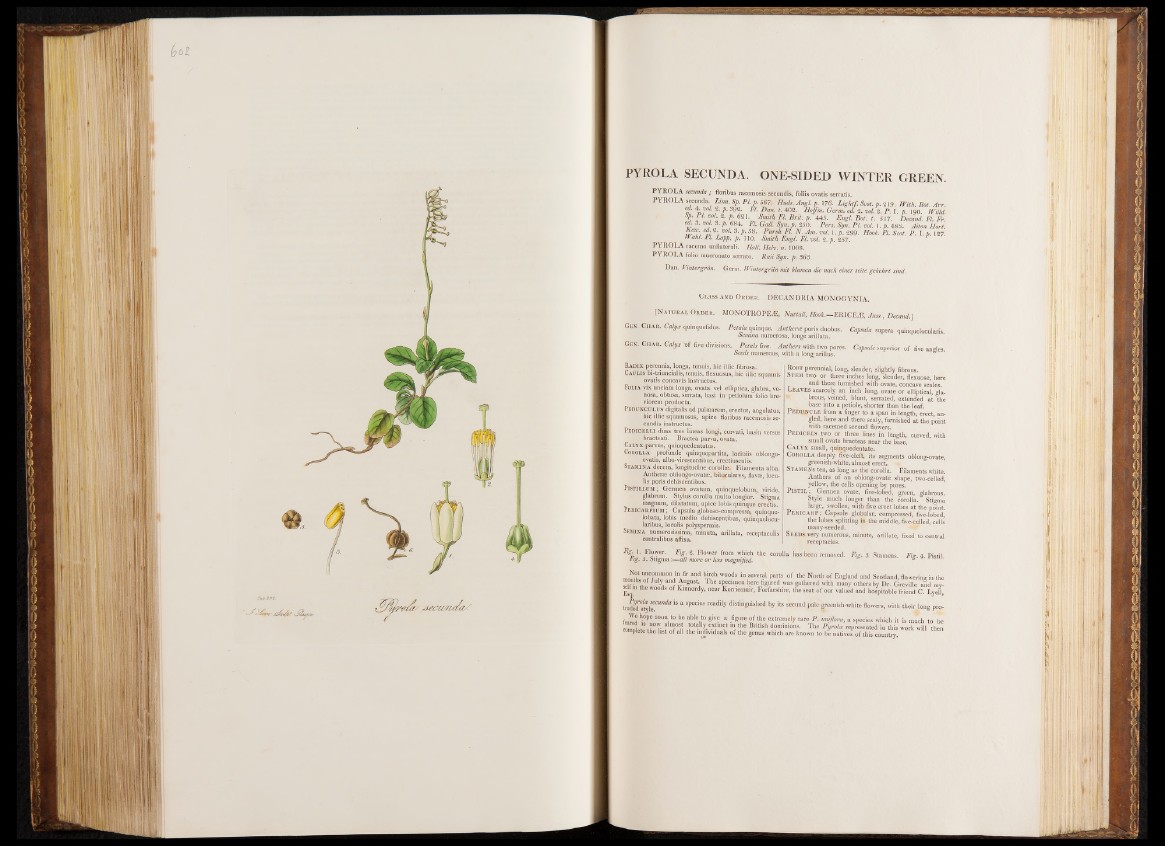
PYROLA SECUNDA. ONE-SIDED WINTER GREEN.
PYROLA secunda; floribus racemosis secundis, foliis ovatig serratis.
PYROLA secunda. Linn. Sp. P l.p . 567. Huds.Angl.p. 176. Liglitf. Scot. p. e 19. With.~Bot.Arr.
e d .4 .v o l.S .p .3 9 S . FI. Dan. t. 402. Rpffm. Germ. e i. 2. ml. 2. P . \ . p. 190. Willd.
Sp PI. ml. 2. £ 631 Smith FI. Brit. p. 445. Engl. Bot. t. 517. Decani. Ft. Fr.
ed. 3. ml. 3. p. 684. Ft. Gall. Syn. p . 250. Pers. Syn: PI. vol. 1. p. 483. Alton Hon.
Kew e i. 2. ml. 3. p. 58. Pursh FI. N . Am. ml. 1. p. 299. Hook. FI. Scot. P . I p. 127.
Wahl. PI. Lapp. p. no. Smith Engl. FI. ml. 2. p . 257.
PYROLA racctno unilaterali. Hall. Helv. n. 1008.
PYROLA folio mucronato gerrato. Raii Syn. p. 363.
Dan. Vintergron. Germ. Wintcrgriin mil hlmnen die nach einer seite gekehrt sind.
Class and Order. DECANDRIA MONOGYNIA.
[Natural Order. MONOTROPEÆ, Nuttall, flco i.-E R IC EÆ , Jus,., -------- i f .
Gen. Char. Calyx quinquefidus. Petala quinque. Anthem ports dnobug. Capsula supera quinquelocularis
oemina numerosa, longe arillata.
Gen. Char. Calyx'eA five divisions. Petals five. Anthers with two pores. Capsule superior of five anales
Seeds numerous, with a long arillus. 6
Radix perennis, longa, tenuis, hie illic fibrosa.
Caulis bi-triuncialis, tenuis, flexuosus, hie illic squamis
ovatis concavis instructus.
Folia vix unciam longa, ovata vel elliptica, glabra, ve-
nosa, obtusa, serrata, basi in petiolum folio bre-
viorem producta.
Pedunculus digitalis ad palmarem, erectus, angulatus,
hie illic squamosus, apice floribus racemosis secundis
instructus.
Pedicelli duas tres lineas longi, curvati, basin versus,
bracteati. Bractea parva, ovata.
Calyx parvus, quinquedentatus.
Corolla profunde quinquepartita, laciniis oblongo-
ovatis, albo-virescentibus, erectiusculis.
Stamina decern, longitudine corollas« Filamenta alba.
Anther* oblongo-ovatas, biloculares, flav*, lbCu-
lis poris dehiscentibus.
PlSTILLUM; Germen ovatum, quinquelobum, viride,
glabrum. Stylus corolla multo longior. Stigma
magnum, dilatatum, apice lobis quinque erectis.
Pericarjpium ; Capsula globoso-compressa; quinque-
lobata, lobis medio dehiscentibus, quinquelocu-
laribus, loculis polyspermis.
Semina numerosissima, minuta, arillata, receptaculis
centralibus affixa.
Root perennial, long, slender, slightly fibrous.
Stem two of three inches long, slender, flexuose, here
and there furnished with ovate, concave scales.
Leaves scarcely an inch long, ovate or elliptical, glabrous,
veined, blunt, serrated, extended at the
base into a petiole, shorter than the leaf.
Peduncle from a finger to a span in length, erect, angled,
here and there scaly, furnished at the point
with racemed second flowers.
P edicels two or three lines in length, curved, with
small ovate bracteas near rhe base.
Calyx small, quinquedentate.
Corolla deeply five-cleft, its segments oblong-ovate,
greenish-white, almost erect. *
Stamens ten, as long as the corolla. Filaments white.
Anthers of an oblong-ovate shape, two-celled,
yellow, the cells opening by pores.
Pist il ; Germen ovate, five-lobed, green, glabrous.
Style much longer than the corolla. Stigma
large, swollen, with five erect lobes at the point.
Pericarp; Capsule globular, compressed, five-lobed,
the lobes splitting in the middle, five-celled, cells
many-seeded.
Seeds very numerous, minute, arillate, fixed to central
receptacles.
/ o '™ 8' F,g;, 3 - Flowe,r from which the cor°Ua has been removed. Fig. Mg. 5. Stigma:—-all more or less magnified. 3. Stamens. F°ir. 4. Pistil
and 'S i? wo°.t!s in several P“rts of Rio North o f England and Scotland, flowerin. in the
sTin w S l i T n ? #-US0S A r , e S?“ " .en b.ere Rgoted was gathered with many others by Dr. Greville and my-
HMn the woods of Rmnordy, near Kernemmr, Forfarshire, the seat o f our valued and hospitable 'friend C. Lyell,
truded* st* *£cu>1^a ls “ sPecies rea<% distinguished by its secund pale greenish-white flowers, with their, long profeared
hu pe SO““i “ bf "b!en° Siv? a .%“re of Rio extremely rare P . uniflora, a species which it is much to be
■eared is now almost totally extinct in the British dominions. The Pyrolx represented in this work will then
complete the list of all the individuals of the genus which are known to b^ native] of S o u n t r J !